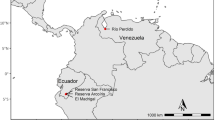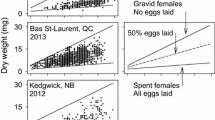Abstract
Adult body mass is a strong correlate of many important life history traits of bees, and thus, has been used as a proxy for these traits in ecological studies. However, body mass is difficult to measure on live specimens in the field, and impossible to measure non-destructively on dry museum specimens. For worker and male bumblebees, we evaluated the linear measures inter-tegular span (IT span) and head width as predictors of fresh and dry weight. For males, linear regressions best explained the relationship between fresh and dry weight and the linear size estimators, while for workers, exponential regressions best explained this relationship. We found that both IT span and head width are precise estimators of weights of bumblebees. Head width was a slightly better predictor of male weights, while IT span was a slightly better predictor of worker weights. IT span and head width changed little by drying. We discuss patterns of size variation in bumblebees, and highlight possible applications of the method in ecological studies.

Similar content being viewed by others
References
Alcock J., Eickwort G.C. and Eickwort K.R. 1977. The reproductive behavior of Anthidium maculosum (Hymenoptera: Megachilidae) and the evolutionary significance of multiple copulations by females. Behav. Ecol. Sociobiol. 2: 385-396
Alcock J. 1979. The relation between female body size and provisioning behavior in the bee Centris pallida Fox (Hymenoptera: Anthophoridae). J. Kans. Entomol. Soc. 52: 623-632
Alford D.V. 1975. Bumblebees. Davis-Poynter, London.
Blanckenhorn W.U. 2000. The evolution of body size: what keeps organisms small? Q. Rev. Biol. 75: 385-407
Bommarco R., Lundin O., Smith H.G. and Rundlöf M. 2012. Drastic historic shifts in bumble-bee community composition in Sweden. Proc. R. Soc. B. Biol. Sci. 279: 309-315
Bosch J. and Vicens N. 2006. Relationship between body size, provisioning rate, longevity and reproductive success in females of the solitary bee Osmia cornuta. Behav. Ecol. Sociobiol. 60: 26-33
Bullock S.H. 1999. Relationships among body size, wing size and mass in bees from a tropical dry forest in México. J. Kans. Entomol. Soc. 72: 426-439
Cane J.H. 1987. Estimation of bee size using intertegular span (Apoidea). J. Kans. Entomol. Soc. 60: 145-147
Couvillon M. and Dornhaus A. 2010. Small worker bumble bees (Bombus impatiens) are hardier against starvation than their larger sisters. Insect. Soc. 57: 193-197
Couvillon M.J., Jandt J.M., Duong N.H.I. and Dornhaus A. 2010. Ontogeny of worker body size distribution in bumble bee (Bombus impatiens) colonies. Ecol. Entomol. 35: 424-435
Dupont Y.L., Damgaard C. and Simonsen V. 2011. Quantitative historical change in bumblebee (Bombus spp.) assemblages of red clover fields. PLoS One 6: e25172.
Gathmann A. and Tscharntke T. 2002. Foraging ranges of solitary bees. J. Anim. Ecol. 71: 757-764
Goulson D. 2010. Bumblebees: Behaviour, Ecology, and Conservation, 2nd Edition. Oxford University Press, Oxford.
Goulson D., Peat J., Stout J.C., Tucker J., Darvill B., Derwent L.C. and Hughes W.O.H. 2002. Can alloethism in workers of the bumblebee, Bombus terrestris, be explained in terms of foraging efficiency? Anim. Behav. 64: 123-130
Greenleaf S., Williams N., Winfree R. and Kremen C. 2007. Bee foraging ranges and their relationship to body size. Oecologia 153: 589-596
Guédot C., Bosch J. and Kemp W.P. 2009. Relationship between body size and homing ability in the genus Osmia (Hymenoptera; Megachilidae). Ecol. Entomol. 34: 158-161
Hagen M., Wikelski M. and Kissling W.D. 2011. Space use of bumblebees (Bombus spp.) revealed by radio-tracking. PLoS One 6: e19997
Heinrich B. 1976. Partitioning among some eusocial insects: bumblebees. Ecology 57: 874-889
Kim J.-Y. 1997. Female size and fitness in the leaf-cutter bee Megachile apicalis. Ecol. Entomol. 22: 275-282
Legendre P. and Legendre L. 1998. Numerical Ecology. 2nd Edn. Elsevier, Amsterdam.
Olesen J.M., Bascompte J., Dupont Y.L., Elberling H. and Jordano P. 2010. Missing and forbidden links in mutualistic networks. Proc. R. Soc. B. Biol. Sci. 278: 725-732
Plowright R. and Jay S. 1968. Caste differentiation in bumblebees (Bombus Latr.: Hym.) I. The determination of female size. Insect. Soc. 15: 171-192
Pouvreau A. 1989. Contribution à l’étude du polyéthisme chez les bourdons Bombus Latr. (Hymenoptera, Apidae). Apidologie 20: 229-244
Pyke G.H. 1978. Optimal body size in bumblebees. Oecologia 34: 255-266
Ramalho M., Imperatriz-Fonseca V.L. and Giannini T.C. 1998. Within-colony size variation of foragers and pollen load capacity in the stingless bee Melipona quadrifasciata anthidioides Lepeletier (Apidae, Hymenoptera). Apidologie 29: 221-228
Regali A. and Rasmont P. 1995. Nouvelles methodes de test pour l’evaluation du regime alimentaire chez des colonies orphelines de Bombus terrestris (L) (Hymenoptera, Apidae). Apidologie 26: 273-281
Ribeiro M.F. 1994. Growth in bumble bee larvae: relation between development time, mass, and amount of pollen ingested. Can. J. Zool. 72: 1978-1985
Roulston T.H. and Cane J.H. 2000. The effect of diet breadth and nesting ecology on body size variation in bees (Apiformes). J. Kans. Entomol. Soc. 73: 129-142
Rust R.W. 1991. Size-weight relationships in Osmia lignaria propinqua Cresson (Hymenoptera: Megachilidae). J. Kans. Entomol. Soc. 64: 174-178
Schmid-Hempel P., Müller C., Schmid-Hempel R. and Shykoff J.A. 1990. Frequency and ecological correlates of parasitism by conopid flies (Conopidae, Diptera) in populations of bumblebees. Insect. Soc. 37: 14-30
Schmid-Hempel R. and Schmid-Hempel P. 1996. Host choice and fitness correlates for conopid flies parasitising bumblebees. Oecologia 107: 71-78
Skandalis D.A., Tattersall G.J., Prager S. and Richards M.H. 2009. Body size and shape of the large carpenter bee, Xylocopa virginica (L.) (Hymenoptera: Apidae). J. Kans. Entomol. Soc. 82: 30-42
Sladen F.W.L. 1912. The Humlebee, its Life History and how to Domesticate it. Macmillan & co, London.
Spaethe J. and Weidenmüller A. 2002. Size variation and foraging rate in bumblebees (Bombus terrestris). Insect. Soc. 49: 142-146
Stang M., Klinkhamer G.L. and van der Meijden E. 2006. Size constraints and flower abundance determine the number of interactions in a plant-flower visitor web. Oikos 112: 111-121
Stang M., Klinkhamer P.G.L. and van der Meijden E. 2007. Asymmetric specialization and extinction risk in plant-flower visitor webs: a matter of morphology or abundance? Oecologia 151: 442-453
Stang M., Klinkhamer P.G.L., Waser N.M., Stang I. and van der Meijden E. 2009. Size-specific interaction patterns and size matching in a plant-pollinator interaction web. Ann. Bot. 103: 1459-1469
Tepedino V.J. and Torchio P.F. 1982. Phenotypic variability in nesting success among Osmia lignaria propinqua females in a glasshouse environment (Hymenoptera: Megachilidae). Ecol. Entomol. 7: 453-462
van Nieuwstadt M.G. and Ruano Iraheta L.C.E. 1996. Relation between size and foraging range in stingless bees (Apidae, Meliponinae). Apidologie 27: 219-228
Woodward G., Ebenman B., Emmerson M., Montoya J.M., Olesen J.M., Valido A. and Warren P.H. 2005. Body size in ecological networks. Trends Ecol. Evol. 20: 402-409
Acknowledgments
We thank H.B. Madsen for identifying bumblebee specimens, H.E. Traun for field assistance, and S. Hangstrup, S. Espersen, G.M. Rasmussen and W.D. Kissling for inspiring discussions. Two anonymous referees provided valuable comments, which improved the manuscript. This project was financially supported by the Danish Natural Sciences Research Council.
Author information
Authors and Affiliations
Corresponding author
Rights and permissions
About this article
Cite this article
Hagen, M., Dupont, Y.L. Inter-tegular span and head width as estimators of fresh and dry body mass in bumblebees (Bombus spp.). Insect. Soc. 60, 251–257 (2013). https://doi.org/10.1007/s00040-013-0290-x
Received:
Revised:
Accepted:
Published:
Issue Date:
DOI: https://doi.org/10.1007/s00040-013-0290-x




